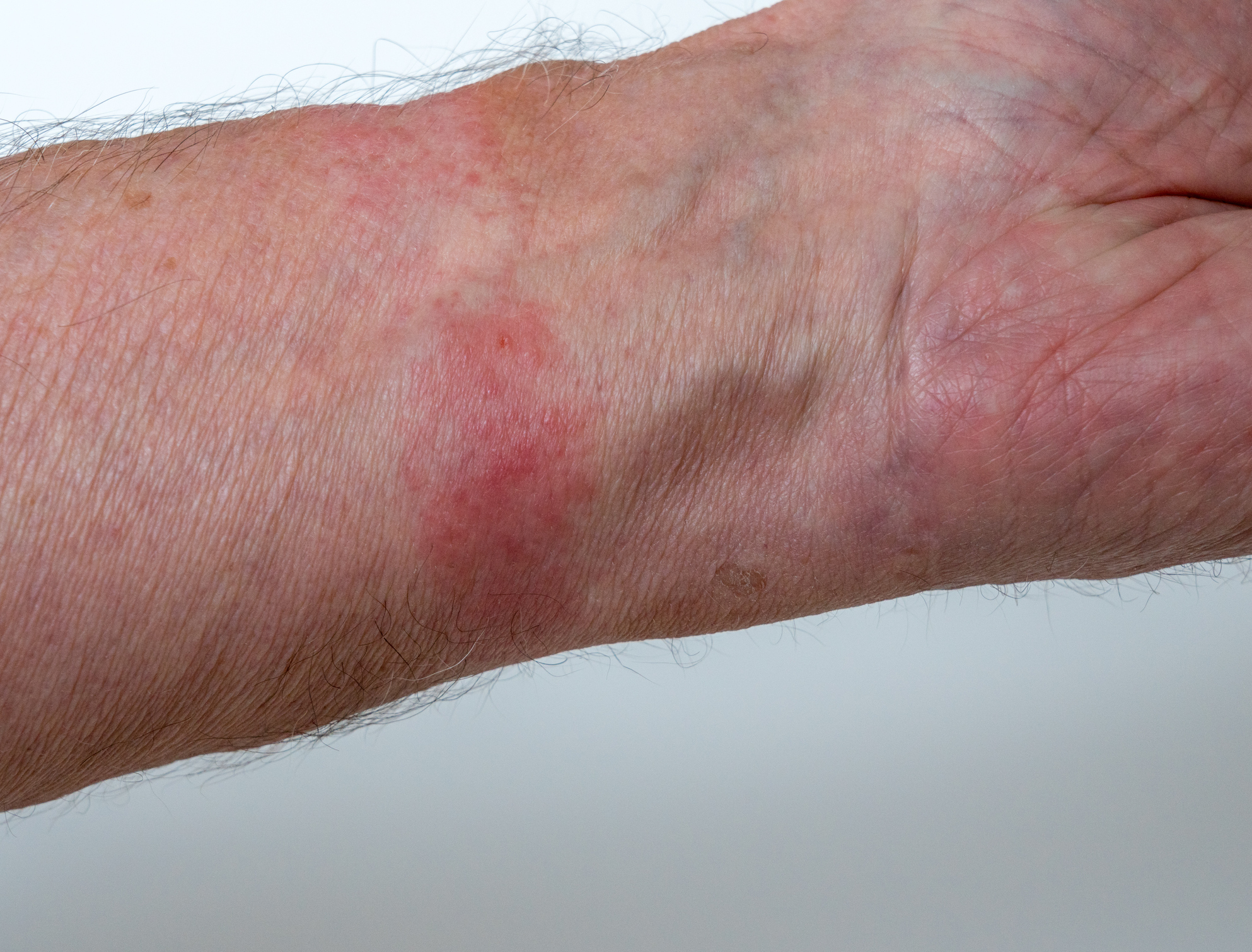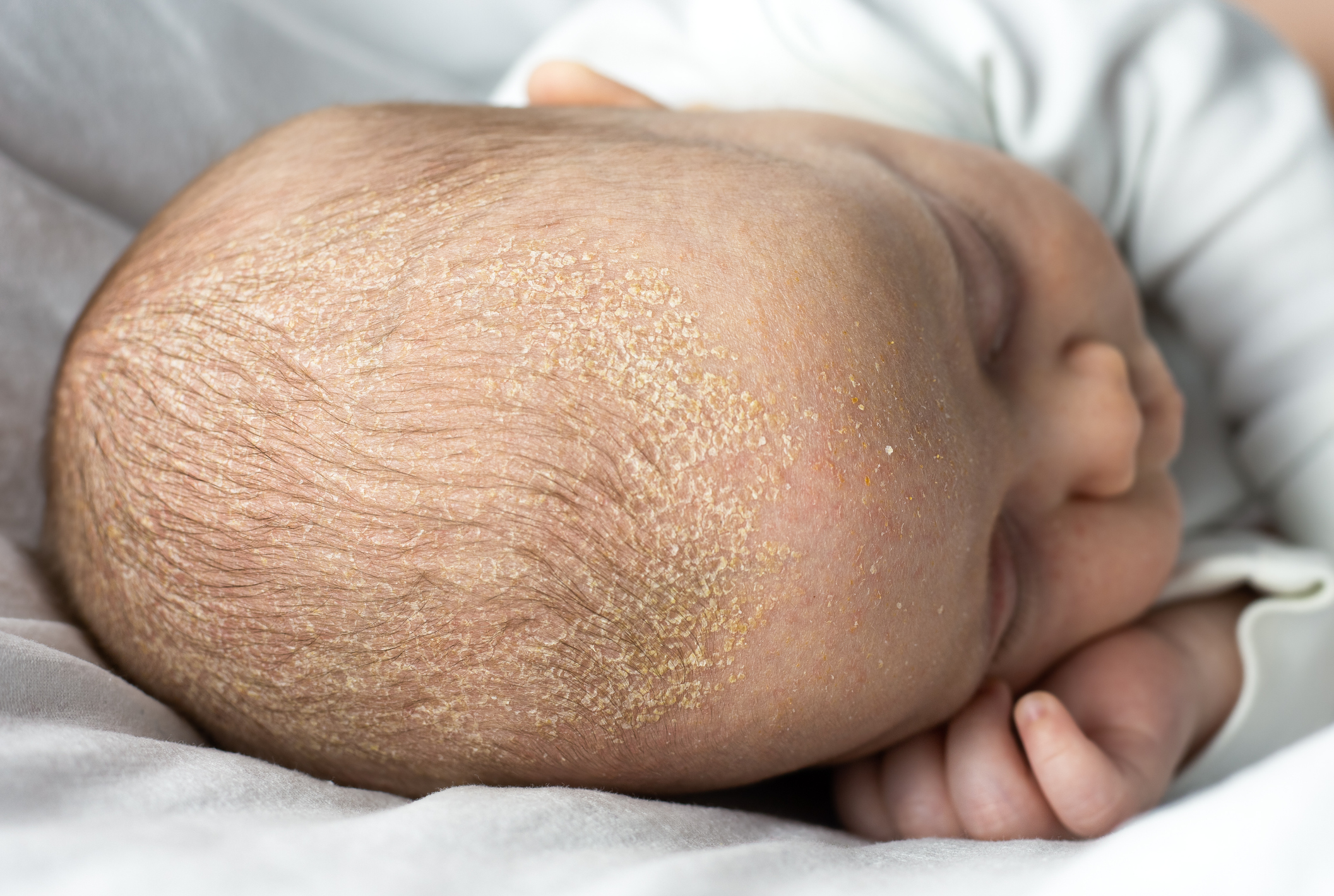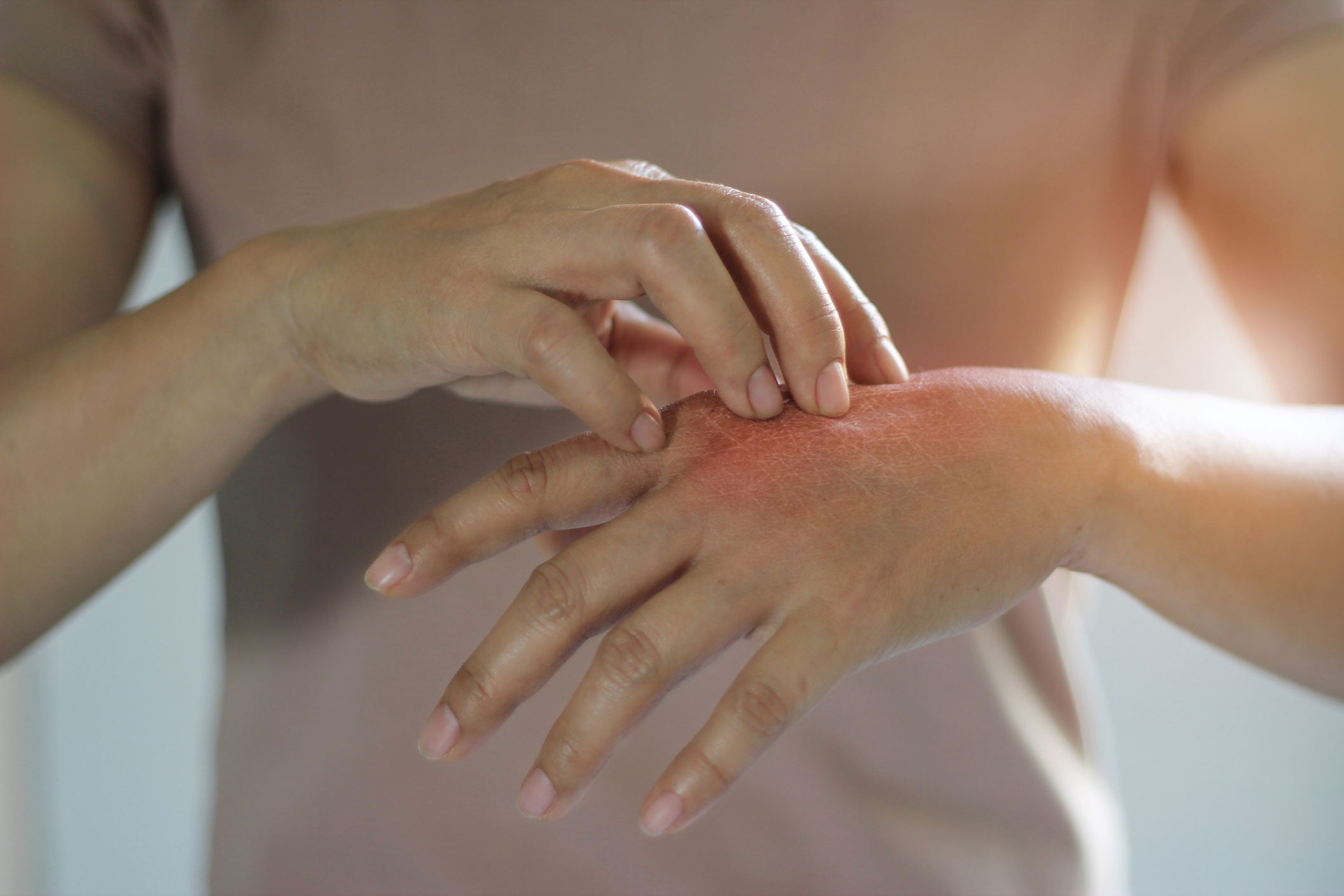- prolekare.cz - Contact dermatitis - part I.
- prolekare.cz - Professional allergic dermatitis
- solen.sk - Phytodermatitis
- prolekare.cz - Contact dermatitis
- mayoclinic.org - Dermatitis
- webmd.com - Contact dermatitis: facts about skin rashes
- sciencedirect.com - Dermatitis
- Jiří Štork et al - DERMATOVENEROLOGY
What is dermatitis? Inflammation of the skin and its causes, symptoms and distribution

Dermatitis is a very common skin disease. However, not all dermatitis is the same. What types of dermatitis do we know?
Most common symptoms
- Skin pain
- Hyperpigmentation
- Rash
- Wetting of the skin
- The Island
- Buds
- Itchy skin
- Reddened skin
- Redness of the eyelid
Characteristics
The disease manifests itself mainly in persons who have altered skin reactivity.
All types of dermatitis are characterized by a tendency to spread, recur and in most cases are chronic (long-term).
Eczema or dermatitis?
Several attempts have been made in medical circles to distinguish dermatitis from eczema. New terminology based on the Anglo-Saxon environment uses the term dermatitis.
In Central European medicine, the term eczema is still used.
Eczema is a type of reaction that has many causes.
According to some experts, every eczema is dermatitis, but not every dermatitis is eczema. Therefore, it is recommended to use the term dermatitis.
Classification and terminology are inconsistent and different publications use different criteria.
Depending on the course, dermatitis is divided into:
- acute dermatitis, which manifests itself during the course of the disease
- subacute
- chronic

Depending on the cause, dermatitis is divided into:
- allergic
- irritant
In the literature we also find a division according to morphology and localisation. In this article we will follow the following division:
- Irritant contact dermatitis (Dermatitis contacta irritativa)
- Allergic contact dermatitis (Dermatitis contacta allergica)
- Microbial dermatitis (Dermatitis nummularis)
- Atopic dermatitis (Dermatitis atopica)
- Seborrhoeic dermatitis (Dermatitis seborrhoica)
- Dyshidrotic dermatitis (Dermatitis dyshidrotica)
Causes
Dermatitis is divided into two groups according to its origin:
- External (exogenous) origin - irritant contact dermatitis, allergic contact dermatitis, microbial dermatitis.
- Internal (endogenous) origin - atopic dermatitis, seborrhoeic dermatitis, dyshidrotic dermatitis
Depending on the cause, the following skin diseases are classified as dermatitis/eczema:
- Irritant contact dermatitis (Dermatitis contacta irritativa)
The disease is caused by non-allergic, irritating external factors. These may be physical, chemical or biological. The course of the disease may be acute (toxic dermatitis), subacute or chronic (cumulative dermatitis).
Symptoms of acute dermatitis become apparent after only a few minutes or hours.
Manifestations of chronic dermatitis occur after repeated contact with the toxic causative factor.
The following table gives individual examples of causative factors
| Chemical causes | Physical causes | Biological causes |
| Water | Heat | plant juices |
| cleaning agents | frost | animal secretions |
| acids | light | microbes |
| cement | dry | |
| lime | damp | |
| mineral oils | pressure | |
| organic solvents | sand |
Plants can be a factor in inducing toxicity. For example, chilli peppers contain the alkaloid capsaicin, which induces the release of a stored neurotransmitter from sensory neurons. As a result, humans experience skin burning.
If protective gloves are not used when working with chilli peppers, contact dermatitis of the hands can occur.
- Allergic contact dermatitis (Dermatitits contacta allergica, Eczema contactum allergicum)
Allergic contact dermatitis is a manifestation of a late type of cellular allergy. The spectrum of the most common contact allergens changes over the course of life. It is largely a reflection of lifestyle and living standards in society.
In many cases, skin inflammation occurs after shaving when the patient uses shaving foam. Also, jewellery (watches, chains) containing nickel can cause skin inflammation.
The following table lists the causes of allergic contact dermatitis by gender
| Women | Men |
| Hair dyes, eyebrows | Shaving foam, cologne (fragrances, parabens) |
| cosmetics (fragrances, parabens) | watches (nickel) |
| necklaces and other jewellery (nickel) | condoms |
| depilatory creams and waxes | cooling emulsions, adhesives (chrome) |

- Microbial dermatitis (Dermattitis nummularis, Eczema microbiale)
The literature does not yet provide a unified view on the causes of this disease. It is assumed that microbial exposure is not a direct cause of the disease.
That is, it is a contact allergy of the skin to bacterial products.
- Dyshidrotic dermatitis (Dermatitis dyshidrotica, Eczema dysidroticum)
Risk factors involved in the development of the disease include irritant allergic influences, infections, psyche and thermal influences.
- Atopic dermatitis (Dermatitis atopica, Eczema atopicum)
Many factors are involved in the development of atopic dermatitis:
- Heredity - The predisposition to atopic dermatitis is hereditary. About 60 to 70% of patients who suffer from this disease have a positive family history of atopy.
- Impaired barrier function of the skin - Decreased immunity to colonization by golden staphylococcus aureus. This bacterium causes increased susceptibility to the development and maintenance of inflammatory diseases.
- Environmental factors - Allergens, temperature and humidity, irritants.
- Psychological factors - Effect of stress.

- Seborrhoeic dermatitis (Dermatitis seborrhoica)
Seborrhoeic dermatitis is a multifactorial disease.
The following factors are involved in the development of seborrhoeic dermatitis:
- excessive sebum production
- proliferation of lipophilic yeasts of the genus Malassezia
- heredity
- other risk factors - excessive sweating, obesity, stress, improper hygiene, HIV infection, medications (corticosteroids, immunosuppressants)
Symptoms
The acute stages of the disease are characterized by many symptoms:
- swelling
- redness
- papules
- blisters
- scabs
The following features are typical of the chronic stages of dermatitis:
- peeling of the skin
- thickening of the skin
- formation of cracks
The clinical picture of dermatitis is influenced by several factors:
- type of dermatitis
- stage
- localization
- age of the patient
- skin care
- previous treatment
- external and internal factors
The following table lists typical symptoms for each type of dermatitis
| Type of dermatitis | Symptoms |
| Irritant contact dermatitis |
|
| Allergic contact dermatitis |
|
| Microbial dermatitis |
|
| Dyshidrotic dermatitis |
|
| Atopic dermatitis |
|
| Seborrheic dermatitis |
|
Read also:
- How should we care for problematic and oily skin? 3 key steps and tips on cosmetics
- How to care for the skin on your hands? Three steps: washing, disinfecting, moisturising

Diagnostics
- Medical history - targeted, detailed
- Clinical picture - morphological manifestations
- Differential diagnostic considerations
- Ancillary examinations - epicutaneous tests, other examinations (histological, bacteriological, mycological, allergological)
In addition to the above steps, the physician should be able to answer the following questions:
- If not, what other diagnoses might be involved?
- What type of eczema is the patient suffering from?
- What is the cause?
- Can the cause or triggering factor be eliminated?
Course
The disease is manifested by small, reddened maculae and pointed papules. The papules cluster in groups. Typically, most papules are located in the centre of the lesions and their number decreases towards the edges.
The basis of the papules is intracellular swelling, which together with intracellular keratinocyte edema leads to vesicle formation. The vesicles enlarge over time and turn into bullae.
The outer thin layer of blisters ruptures easily. They coalesce into swollen foci or larger areas. The tissue fluid that forms after blister rupture dries over time and forms scabs.
In the chronic course of the disease, patients often have the urge to scratch the affected areas.
This scratching leads to thickening of the surface (lichenification). This thickening, together with thickening of the stratum corneum, becomes the basis for the development of hyperkeratotic eczema.
The formation of skin rashes is gradual. There are coexisting manifestations at different stages of development. The severe itching which is a symptom of most dermatitis leads to the formation of abrasions.
Scratching of rashes is dangerous because it can lead to secondary infection.
The manifestations of acute dermatitis are easily recognisable. The lesions have blurred edges, are red and swollen. The lesions contain papules, vesicles or lumps.
Chronic dermatitis is characterised by peeling, thickened and hyperpigmented lesions. These have a roughened surface. Cracks often form.

What dietary and regimen measures should patients follow?
In general, patients are advised not to eat spicy, sour, spicy and aromatic foods. They should also avoid alcohol.
There is no universal diet for eczema.
Doctors recommend that patients follow a diet that is similar to the gallbladder diet.
How to recipes for gallbladder diet? + Foods that do not irritate the gallbladder
What are the basics and principles of the gallbladder diet? What foods to eat/not eat?
The diet for this gallbladder diet consists of the following foods:
- vegetables without grains
- fruit without grains and skins
- processed fruit - in the form of jams or juices
- lean meat - turkey, chicken, rabbit, beef, fish
- vegetable or meat soups
- milk and milk products (with a fat content of up to 1,5 %)
- hard cheeses (up to 30 % fat)
- vegetable oils - olive, sunflower
- non-fat pastries
- biscuits
- children's biscuits
- cereals
- pasta
- rice
- potatoes
Basic recommendations include:
- Gentle hygienic skin care - use non-irritating soaps and shampoos.
- Limit contact with water to the shortest possible time.
- Do not dry skin after showering by rubbing with a towel.
- Patients should skip cosmetic products - make-up, nail polish, hairspray, etc.
- Wear appropriate clothing - cotton, smooth, airy.
- Do not smoke.
- Rooms in the apartment should be ventilated regularly.
- The apartment or house should be vacuumed every day.
How it is treated: Dermatitis - inflammation of the skin
How is dermatitis treated? Medications, topical ointments, creams, herbs and more
Show moreDermatitis is treated by
Other names
Interesting resources
Related










